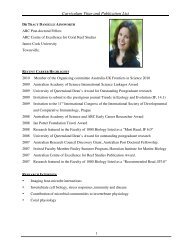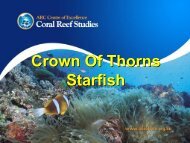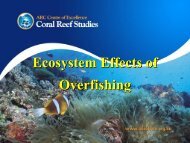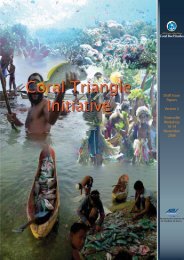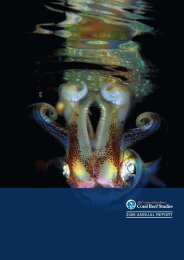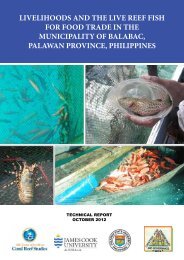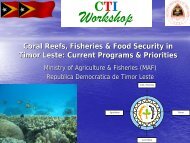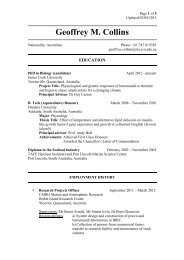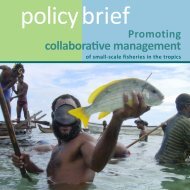Download - ARC Centre of Excellence for Coral Reef Studies
Download - ARC Centre of Excellence for Coral Reef Studies
Download - ARC Centre of Excellence for Coral Reef Studies
Create successful ePaper yourself
Turn your PDF publications into a flip-book with our unique Google optimized e-Paper software.
Program 3:Marine Reserves and<strong>Reef</strong> ConnectivityResearchersGarry Russ (Program Leader)Glenn Almany (Research Fellow)Andrew Baird (Research Fellow)David BellwoodSean ConnollyTerry Hughes (Research Fellow)Ge<strong>of</strong>frey JonesMichael Kings<strong>for</strong>dLaurence McCookMark McCormickMark MeekanPhilip Munday (Research Fellow)Serge PlanesJohn PandolfiMorgan Pratchett (Research Fellow)Garry RussBette WillisNetworks <strong>of</strong> marine reserves (no-takezones) are used to manage biodiversityand fi sheries. Consequently, zoning <strong>for</strong>multiple levels <strong>of</strong> usage and protectionis fast becoming the principal mode <strong>of</strong>management <strong>of</strong> maritime resources.An improved understanding <strong>of</strong> marineconnectivity and barriers to dispersal iscentral to this endeavor.<strong>Centre</strong> research fellow Glenn Almany andcolleagues have continued to developnovel methods <strong>for</strong> direct marking <strong>of</strong>larval fi shes, and have conducted anumber <strong>of</strong> trials in Australia, Indonesiaand PNG, using a range <strong>of</strong> reef fi sh,including several <strong>of</strong> major commercialand recreational importance (e.g. largegroupers, including coral trout). Theseexperiments employ enriched isotopelarval markers to quantify exchangeamong adjacent subpopulations andexamine export <strong>of</strong> larvae from their natalreef. A key paper, based on these newtechnologies, is in press in Science.In 2006, Program Leader Garry Russand colleagues completed the fi rstfi eld assessments <strong>of</strong> the new re-zoningon nearshore reefs the Great Barrier<strong>Reef</strong> Marine Park. Initial data from theWhitsunday Islands indicated a relativelyfast and positive response <strong>of</strong> targetedreef fi sh populations to the new zoning.Ge<strong>of</strong>f Jones, Glen Almany and Garryalso began pilot experiments to test ifno-take zones in the Keppel Islands <strong>of</strong>Great Barrier <strong>Reef</strong> (GBR) export larvae<strong>of</strong> commercially and recreationallyimportant reef fi sh to adjacent fi shedareas. Clearly, this work is highly relevant<strong>for</strong> numerous management agenciesresponsible <strong>for</strong> the sustainability <strong>of</strong> theGBR Marine Park.Garry continues to work in the Philippineswith colleague Angel Alcala, with theimplementation <strong>of</strong> a major new researchprogram in 2006. It will produce anoceanographic and larval dispersalmodel <strong>of</strong> the region (the Bohol Sea) and arigorous biogeographic description <strong>of</strong> thecoral reef fauna. This new in<strong>for</strong>mationwill be used as inputs into a major siteselectionprocess to assist in designingand expanding the marine reservenetwork in the Philippines.Ge<strong>of</strong>f Jones and Partner InvestigatorSerge Planes from the University <strong>of</strong>Perpignan have been awarded additionalfunding from the <strong>Coral</strong> <strong>Reef</strong> Initiative <strong>of</strong>the South Pacifi c (CRISP) program. Theirproject will provide critical in<strong>for</strong>mation onthe size and spacing <strong>of</strong> marine protectedareas, and develop an understanding<strong>of</strong> how reef fi sh populations are likelyto respond to increasing scales <strong>of</strong> coralreef degradation. Ge<strong>of</strong>f and Canadiancolleague Peter Sale will lead a joint<strong>ARC</strong> <strong>Centre</strong> <strong>of</strong> <strong>Excellence</strong>-World BankGlobal Environment Fund (GEF) workshopin Townsville next year on “New insightsinto connectivity and implications <strong>for</strong>coral reef management”.Program 3 has clearly defi ned and directlinks to Program 1 (contemporary andhistorical fi shing levels on the GreatBarrier <strong>Reef</strong>), Program 2 (management<strong>of</strong> biodiversity within and outside marinereserves), Program 4 (prevalence <strong>of</strong>coral diseases inside and outside marinereserves) and Program 5 (communitybasedmanagement <strong>of</strong> marine reservesand its relationship to social andgovernance systems).18



